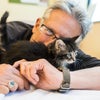I learned lots of things in Brooklyn's Ditmas Junior High School, back in the 1960s, sadly most long forgotten. But I do remember learning one thing that is not true. We were taught that two abilities separate us from all other animals: use of tools and language.
Since then we've lost that clear line in the biological sand. Squids use tools, dolphins have language, and that doesn't begin to touch animals who live on land. While things are not as black-and-white as my 9th grade science teacher explained, no other species has our degree of tool-making skill. From knapping flint into arrowheads, to those ponderous early printing presses which slowly turned out thousands of printed pages, to the extraordinary phone/computer/camera which now sits in our pockets, humans are definitely tool-making critters.
Which is a round-about way of introducing you to the new, state-of-the-art tool we've just unwrapped, a complex tool that will save tens of thousands of lives for decades to come. I am excited to announce the development of Peninsula Humane Society & SPCA's new tool, the opening of our new animal shelter, the Tom and Annette Lantos Center For Compassion.
A first of its kind in the nation, PHS/SPCA's new Center is literally that: a life-saving tool. A 57,600 square foot, three-story-tall life-saving tool built to care for animals in need. While we'll continue to run the government-mandated animal contracted work at the Airport Boulevard shelter, our charitably funded programs have now moved into their new home after years in the planning and construction.
Gone are the cinderblocks, chain-link fences and stainless steel boxes housing animals up for adoption. Instead, dogs and cats are cared for in homelike yet still completely efficient dog dorms and cat condos: roomy, fun spaces designed with the latest in veterinary technology to prevent stress and disease. And not just dogs and cats! PHS/SPCA remains an open-door facility, so our iguanas, rabbits and parrots will also enjoy the right lighting, temperature, air-exchanges in specially constructed, spacious habitats.
Having long guaranteed a home to every healthy dog and cat in our care, our donor-supported Hope Program makes well and then finds homes for thousands of companion animals with medical and behavioral issues. As part of that, years ago PHS/SPCA pioneered a new concept: the kitten nursery. That early work happened in a small building behind the shelter, jury-rigged so volunteers and staff could provide the demanding needs of abandoned kittens too young to be safely housed in a standard shelter environment. That pilot work leads now to the first nursery specifically designed for this use. And as you'll see when you visit (and I do hope you'll visit -- yeah, I could post photos, but I really want you to come by), we've gone from "behind" the shelter to right up front, in fact...
... we've worked to take much of what has historically been behind the scenes and bring it up front for all to see. Not only is the kitten nursery in the open, but so too is a great deal of our wildlife rehabilitation program. First in the nation, U.S. Fish and Wildlife Service granted us permits combining rehabilitation and education. At the Lantos Center, you'll watch technicians care for tiny baby wild animals. And while the hawks and owls must remain sequestered to prevent developing an unhealthy comfort around people, their large flight aviaries have hidden cameras to capture and project their fascinating lives on large screens in our shelter, and into your home through our website.
Visible now, too, is the dog behavior work of our Hope Program. The Center includes a two-story tall park actually inside the building (with an operable roof for natural light, and a water feature just for the fun of it!). Visitors can watch as we heal and help our behavior Hope Dogs.
And while our veterinary medical work must, of course, continue to go on largely behind the scenes, the Center has veterinary medical clinics for dog, for cats, and for wildlife. It's all there, and it's all for the animals.
But with construction finally done, it's been all about moving these past few weeks. Moving stinks, as most of us would agree, so just try moving with over 400 dogs and puppies, cats and kittens, rabbits, turtles, guinea pigs, parakeets, boa constrictors, red tail hawks, goldfinches, raccoons and baby squirrels. This move was most carefully planned and thought through by staff and volunteers, with all focus on just how to stage such an exodus with the least stress to the animals. Wonderfully, all that worry and planning paid off, quite beautifully.
Among the highpoints: I watched one staff member and one volunteer as they playfully coaxed the first dog to make the move, Bacon, down the hallway and into his brand new doggie dorm. With a big goofy smile, he sniffed and circled his new digs, explored the custom-made furniture, and cuddled with his volunteer. When his body language said he was ready, the humans knelt for a "see you later" kiss and left the room as he jumped up into his new bed and fell instantly and soundly asleep. We all watched him, through his windows, with great relief.
Day after day, animal after animal, success story after success story: the people are exhausted and relieved, and the animals sure look happy. Cats sleeping in hammocks, dogs romping in the indoor park, turtles swimming in their pond... It's still a shelter instead of a home, but we all feel that our animals are now in the best shelter ever built while they wait for those new forever families to find them. We sure hope you'll come by soon to visit. (Did I mention the Doggy Diner Head? Seriously, you've got to visit.) Because whether or not adoption is in your plans, as animal-people this is most definitely worth seeing! 1450 Rollins Road in Burlingame, open and saving lives every day.
